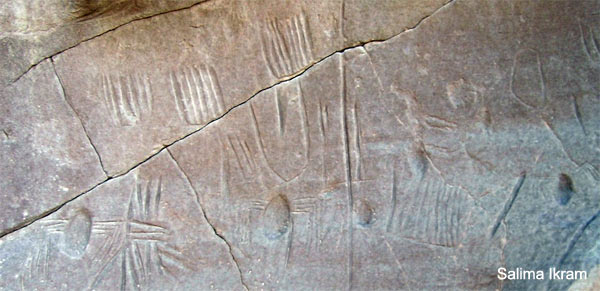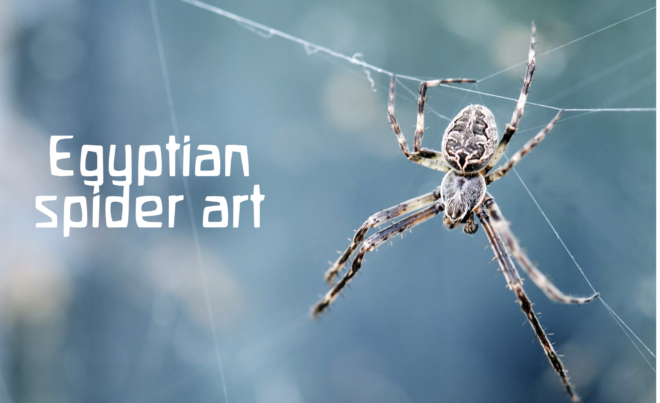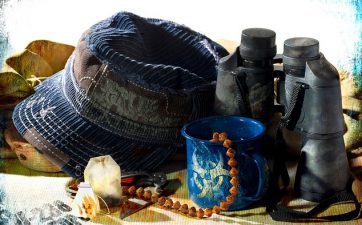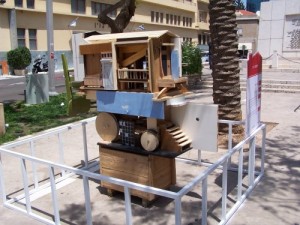Egypt offers more to desert tourists than camels: In the ancient land of the Pharaohs, desert-dwelling invertebrates have often been part of Egyptian folklore, including scarab or dung beetles which are known to navigate by the stars. Now spiders join the story.
Desert spiders have not been a major part of Egyptian hieroglyphic art, but a one of a kind type of “spider art” has now been discovered carved on rocks in Egypt’s western desert. The spider art, said to be around 4,000 years old, was discovered carved into a wall and found in a sandstone wadi in the Kharga Oasis, located in Egypt’s western desert almost 100 miles west of Luxor.

One researcher postulates that the spider art is a form of archaic writing:
However, Derek Cunningham, author of The Long Journey: 400,000 Years of Stone Age Science has his own interpretation.
Cunningham saw the panel as a chance to do an analysis on the art piece to see if the linear comb patterns matched his proposal that such patterns are in fact an archaic form of writing.
The most striking result of his analysis is that the rock panel matches exactly the proposed theory. The angular offset of the ‘spider body’ and the many lines drawn on the panel, align as predicted astronomical values considered central to the accurate prediction of lunar and solar eclipses.

For example, the body of the proposed spiders are rotated by 13.66 degrees from vertical, a calculation which corresponds to half a sidereal month. This appears to link to the observation that the panel faced eastwards, which is the direction astronomers face to observe lunar eclipses.
Spiders are quite numerous in Africa’s desert regions and because some of them having dangerous bites, they may have been incorporated into ancient religious beliefs.
 Worshiping spiders in ancient may also be connected to an Egyptian goddess named Nit or Neith who was said to have been the goddess of weaving, war and hunting. The weaving attribution is drawings and images of Neith often show her carrying a bow and arrows linking her to war and hunting.
Worshiping spiders in ancient may also be connected to an Egyptian goddess named Nit or Neith who was said to have been the goddess of weaving, war and hunting. The weaving attribution is drawings and images of Neith often show her carrying a bow and arrows linking her to war and hunting.
The spider connection comes from Neith weaving or spinning a woven design, like a spider’s web as part of her role in Creation.
Other small invertebrate desert dwellers, particularly scorpions also have Egyptian religious connotation. Scorpions, which are related to spiders, also have eight legs as well as painful and often fatal stings.
Ancient Egyptian writings tell about an ancient Egyptian king possibly called Selk or Weha; and also known as King Scorpion. Selk was said to be the second of two kings or chieftains of that name during the pre-dynastic period of Upper Egypt, called the Protodynastic Period.
Egypt at that time was divided in two kingdoms; the Upper Kingdom with its capital at Thebes; and the lower kingdom, with its capital Memphis, now Cairo.
The lower kingdom included the entire Nile Delta region. The significance of the Scorpion King is that he helped to unite the two kingdoms into one major kingdom at the end of the Protodynistic Period. Ethiopia at odds with Egypt over the Nile could make use of a uniting king these days. Spider or otherwise.
As the spider art paintings are said to be very old, they represent a more ancient concept of Egyptian folklore, and may have been carved out of high respect for the desert spider species whose venomous bites were obviously feared and respected.
Michael Ledo, a Green Prophet reader says that the spider art may be an ancient Zodiac symbol: “Seems no scholar knows that the spider was a zodiac constellation and when it was the summer solstice which would relate to the myths. Also key to dating the cult.”
Read more about other desert invertebrates, including locusts and scorpions:
Scarab (Dung) Beetles Navigate by the Stars
Swarms! Algeria, Libya, Mauritania and Morocco on High Alert for Desert Locusts
What Camels and scorpions Teach “Dayma” Tourists in Egypt
Illustration of Egyptian goddess Neith





